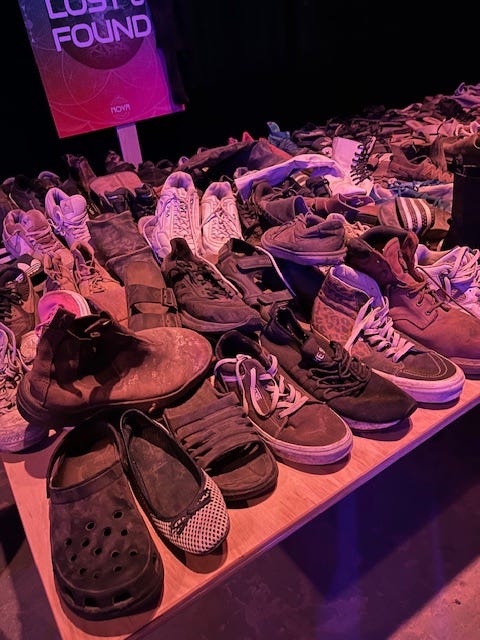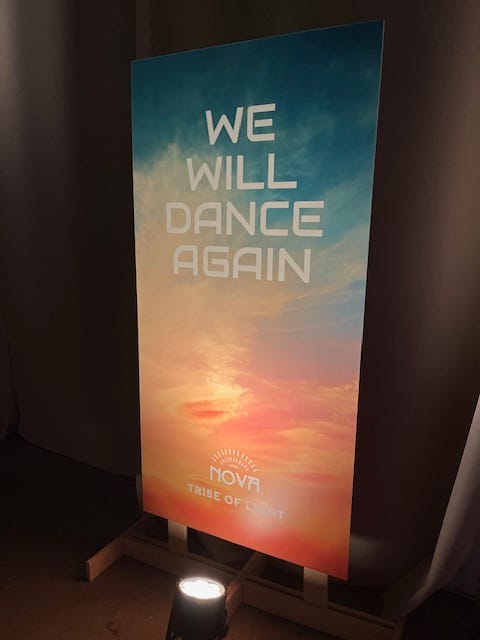A ‘Hallowed Space’ In Downtown New York
Nova Music Festival Exhibit offers an intense, sensitively curated experience in reliving the shock of October 7.
Before tragedy struck: More than 3,000 young people attended the all-night rave.
It’s emotionally hard to visit the Nova Music Festival Exhibit in Lower Manhattan, knowing its goal is to provide you with the experience of shock, trauma and terror that thousands of young Israelis endured the morning of October 7.
With it all, it’s even harder to leave.
My wife and I came away both saddened and inspired, having witnessed scenes of the brutal tragedy, but also learning of the heroism of survivors who saved lives that day, and others who tended to the wounded and dying. Several survivors, in video interviews, expressed a life-changing commitment to bring light into the world in memory of the 364 people who were murdered that day. At least 40 people were taken hostage in Gaza.
We spent two and a half hours at the 50,000-square foot space on Wall Street that has been transformed into a meticulously curated recreation of that tragic event, even including dirt from the festival grounds. The organizers of the exhibit, titled “6:29 a.m.: The Moment Music Stood Still,” have managed to convey the dramatically shifting spirit and mood of the festival itself, from heavenly bliss during the long night to hellish horrors at sunrise.
Even those who have seen many videos and photos and read countless reports of the attack are sure to gain a deeper insight into the event and its impact through this fully immersive experience.
On arrival, you first witness the pure joy and spiritual element of the night’s electronic-dance rave. Videos on a large screen show the smiling faces of the dancers. Post-October 7 interviews with several of the event's producers describe the happiness and celebratory sense of well-being among the thousands drawn to the Negev site. How wickedly ironic that these peace-seekers were soon to be the targets of barbaric terrorists.
After a few minutes you are invited to go up several stairs and enter a large room where you are immediately disoriented by the dark, crowded space and loud noises coming from dozens of various-sized video screens. They show the moment the DJs begin yelling “red alert!” to the confused crowd, followed by chaos as terrorists pursue, shoot at and capture desperately fleeing festival goers.
As you make your way in the dark, amidst trees of various sizes, all around you are actual objects salvaged from the festival site: tents, sleeping bags, lawn chairs, bullet-riddled bathroom stalls, backpacks, cell phones, t-shirts and other personal items.
In the dark: recreating the scene at the festival before dawn.
Throughout the room are dozens of screens with videos of raw footage, some taken by terrified attendees, trying to reach loved ones, and some taken by the the jubilant Hamas terrorists, praising Allah as they hunt down their prey. Sounds of gunfire and yelling are constant. The intent is to make you feel fear and confusion, and it’s all-too effective.
In a room that has a sign warning visitors of “disturbing content” that includes “graphic descriptions of sexual violence,” Zaka volunteers emotionally detail the condition of the mutilated bodies they found when they arrived at the scene and during the weeks they were present.
Modeled On 9/11 Museum
The original exhibit was installed in a large hangar in Tel Aviv. It opened in early December and was open to the public for 10 weeks before being shipped to New York. Israeli President Isaac Herzog attended the Tel Aviv opening and called the site “a hallowed space … silent testimony in memory of all the tremendous human beauty that was lost.”
The New York exhibit is not only located physically near the site of the 9/11 attack on the World Trade Center but is modeled in many ways after the 9/11 Memorial Museum, which tells its story through thousands of objects from the wreckage and video interviews with survivors. “We aimed for this project to be the closest we could bring it to the 9/11 Memorial,” Yoni Feingold, one of the creators of the exhibit, told The Art Newspaper. “That’s exactly the connection we want people to make.”
There is a bit more light as you reach a large, open and quiet area of the exhibit that includes a re-creation of the Nova festival’s main stage, huge sound system and very large video screens of the festival goers dancing. There are also smaller screens offering testimonies from survivors describing what they saw, how they escaped, and how their lives have changed. On one side of the room are several completely burned out cars, representing the many hundreds that were destroyed on October 7. A “Lost and Found” area has tables with piles of clothing, games, books, hats, watches and other personal items found at the scene. Stacks of sneakers and sandals conjure up powerful images of the endless piles of shoes exhibited at Yad Vashem and at Auschwitz.
Haunting memories: contemporary footwear and long ago images.
One of the many remarkable volunteers who helped sort through the belongings at the scene said, on a video, “sometimes you find a tooth or a charred bone,” noting that “way more than 20,000 items were tagged and scanned.” Despite the grim work, she said she took comfort in learning that a personal item she found belonging to a young woman victim was sent to her parents.
Finally, entering the last section of the exhibit, one experiences a calming effect. The large expanse is inviting and you feel your body starting to relax. The area is well-lit and includes several sofas, coloring books, and a “healing tent,” all part of an effort to encourage contemplation and to reflect the spirit of the Tribe of Nova Foundation, a non-profit musical community created in Israel by founders and survivors of the festival. Its goal is to honor the victims, promote the positive power of music in bringing people together and to provide financial, mental, occupational and social assistance to survivors and their families, as well as to hostages and their families.
Real names, real lives remembered.
Another area contains three walls of the photos and names of all of the victims murdered at the festival. Nearby, there are blank cards and pens, with a request to offer reactions to the exhibit. Visitors are encouraged to speak out for the safe return of the hostages still being held in Gaza. The day we visited, two survivors of the festival were manning a small table near the exit, eager to engage with visitors.
On one wall is a large sign – and near the exit, a poster with the same message — underscoring the indelible spirit of Jewish faith and resilience.
It reads: “We Will Dance Again.”
Note: The exhibit, which opened on April 21 at 35 Wall Street, recently extended its New York run until June 16 due to demand.
https://www.novaexhibition.com/
—-------









I agree with Bonnie. A perfect take on this most important and heartbreaking exhibit.
Gary, your post captured so accurately and extensively the Nova Exhibition. You wrote everything I would have wanted to say should I have been able to put it into words. And the photos you featured were ones I would have published.